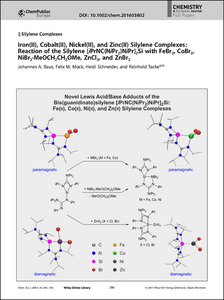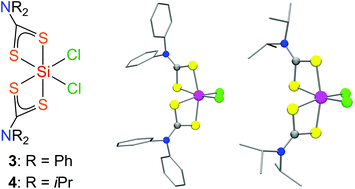Publications
Overview of all Publications, Reviews, Patents, Abstracts and Conference Contributions
Current list of publications and lectures including 2018:
-
 Publikationsverzeichnis_aktuell_Originalpublikationen.pdf Current publication list (1975 - 2018)
Publikationsverzeichnis_aktuell_Originalpublikationen.pdf Current publication list (1975 - 2018)
************************************************************************
Dalton Trans. 46, 13628-13659 (2017), Issue 40, 2017
DOI: 10.1039/C7DT01297G
Bis(amidinato)- and bis(guanidinato)silylenes and silylenes with one sterically demanding amidinato or guanidinato ligand: synthesis and reactivity
Reinhold Tacke and Tatjana Ribeck
This article deals with the synthesis and reactivity of the bis(amidinato)silylene [iPrNC(Ph)NiPr]2Si (5), the bis(guanidinato)silylene [iPrNC(NiPr2)NiPr]2Si (6), the mono(amidinato)silylene [DippNC(Ph)NDipp]SiNMe2 (Dipp = 2,6-diisopropylphenyl) (8) and the mono(guanidinato)silylene [DippNC(NMe2)NDipp]SiN(SiMe3)2 (9). The reactions studied include (i) nucleophilic substitutions, (ii) Lewis acid/base reactions, (iii) Brønsted acid/base reactions, (iv) oxidative additions (bond activations, small-molecule activations), (v) cycloaddition reactions with unsaturated organic substrates, (vi) reductions and (vii) radical formation by muonium addition. Silylenes 5, 6, 8 and 9 have been demonstrated to display unique reactivity profiles and to be versatile precursors for the synthesis of novel four- or five-coordinate silicon(II) and four-, five- or six-coordinate silicon(IV) complexes with unprecedented structural motifs. This article also deals with the structural characterisation of all the new silicon(II) and silicon(IV) compounds synthesised. Crystal structure analyses and 29Si NMR spectroscopic studies in the solid state and in solution were used to characterise the silicon coordination polyhedra of these compounds.
- This article is part of the themed collection: 2017 Frontier and Perspective articles
************************************************************************
Chemistry - A European Journal" 23, 296-303 (2017) - Frontispiece
Iron(II), cobalt(II), and zinc(II) silylene complexes: reaction of the silylene [i(PrNC(NiPr2)NiPr2]Si with FeBr2, CoBr2, NiBe2 • MeOCH2CH2OMe, ZnCl2, and ZnBr2
Authors: Johannes A. Baus, Dr. Felix M. Mück, Heidi Schneider, Prof. Dr. Reinhold Tacke
Link: onlinelibrary.wiley.com/doi/10.1002/chem.201780263/full
Chem. Eur. J. 23, 296-303 (2017). more ...
Abstract:
Donor-Stabilized Silylenes The chemistry of donor-stabilized silylenes has developed into one of the most actively studied research areas in molecular silicon chemistry. In their Full Paper on page 296 ff., R. Tacke et al report on the synthesis and characterization of novel transition-metal silylene complexes of FeBr2, CoBr2, NiBr2, ZnBr2, and ZnCl2 with the bis(guanidinato)silicon(II) complex [iPrNC(NiPr2)NiPr]2Si. These compounds represent very rare examples of carbonyl-free silylene complexes of 3d transition metals in the formal oxidation state +2.
************************************************************************
Dalton Transactions 2017, Advance Article
DOI: 10.1039/C6DT03264H, Received 18 Aug 2016, Accepted 27 Sep 2016
First published online 07 Oct 2016
DOI: 10.1039/c6dt03264h read more ...
Neutral six-coordinate bis(dithiocarbamato)-silicon(IV) complexes with an SiCl2S4 skeleton
Dr. Johannes A. Baus and Prof. Dr. Reinhold Tacke
Abstract
Treatment of SiCl4 with lithium dithiocarbamates of the formula type Li[R2NCS2] (R = Ph, iPr) in a molar ratio of 1![]() :
:![]() 2 afforded the respective six-coordinate silicon(IV) complexes [Ph2NCS2]2SiCl2 (3) and [iPr2NCS2]2SiCl2 (4), which were isolated as the solvates 3·MeCN and 4·MeCN. Compounds 3·MeCN and 4·MeCN were structurally characterised by single-crystal X-ray diffraction and multinuclear NMR spectroscopic studies in the solid state and in solution. In this study, dithiocarbamato ligands were implemented in silicon coordination chemistry for the first time. Compounds 3 and 4 represent the first six-coordinate silicon(IV) complexes with an SiCl2S4 skeleton.
2 afforded the respective six-coordinate silicon(IV) complexes [Ph2NCS2]2SiCl2 (3) and [iPr2NCS2]2SiCl2 (4), which were isolated as the solvates 3·MeCN and 4·MeCN. Compounds 3·MeCN and 4·MeCN were structurally characterised by single-crystal X-ray diffraction and multinuclear NMR spectroscopic studies in the solid state and in solution. In this study, dithiocarbamato ligands were implemented in silicon coordination chemistry for the first time. Compounds 3 and 4 represent the first six-coordinate silicon(IV) complexes with an SiCl2S4 skeleton.
************************************
Eur. J. Inorg. Chem., 186-191 (2017)
Volume 2017, Issue 1 (January 3, 2017), Pages 186–191
Silylene-Induced Reduction of [Mn2(CO)10]: Formation of a Five-Coordinate Silicon(IV) Complex with an O-Bound [(OC)4Mn=Mn(CO)4]2– Ligand
Authors:
Johannes A. Baus, Jordi Poater, F. Matthias Bickelhaupt and Reinhold Tacke
Abstract:
Based on a new silylene-induced reduction of [Mn2(CO)10], a five-coordinate silicon(IV) complex was synthesized, which is formally built up by an anionic [(OC)4Mn=Mn(CO)4]2– and a cationic {[iPrNC(NiPr2)NiPr]2Si}2+ fragment, which are connected by a nearly linear Si–O–C moiety. The Si–O and the C–O bond of this Si–O–C moiety display partial double-bond character.
************************************************************************







